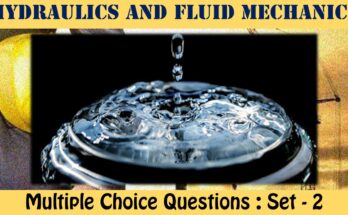MCQ Questions Civil Engineering Surveying
The interviewer is almost as nervous as the candidate in most interviews. You might wonder if you look confident enough, if you will hire the right person, or if you are asking the right engineering interview questions. The last question is arguably the most crucial part to worry about when you’re interviewing candidates. Other topics on Civil Engineering Multiple Choice Questions can be accessed
MCQ Questions Civil Engineering Surveying - Set - 2
Question 1:
For a line AB
a) the forebearing of AB and back bearing of AB differ by 180°
b) the forebearing of AB and back bearing of BA differ by 180°
c) both (a) and (b) are correct.
d) none is correct
Correct Answer – (A)
Question 2 :
If the true bearing of a line AB is 269° 30′, then the azimuth of the line AB is
a) 0° 30′
b) 89° 30′
c) 90° 30′
d) 269° 30′
Correct Answer – (C)
Question 3 :
The length of a chain is measured from
a) centre of one handle to centre of other handle
b) outside of one handle to outside of other handle
c) outside of one handle to inside of other handle
d) inside of one handle to inside of other handle
Correct Answer – (B)
Question 4 :
The maximum tolerance in a 20 m chain is
a) ±2 mm
b) ±3 mm
c) ±5 mm
d) ±8 mm
Correct Answer – (C)
Question 5 :
Which of the following is not used in measuring perpendicular offsets ?
a) line ranger
b) steel tape
c) optical square
d) cross staff
Correct Answer – (A)
MCQ Questions Civil Engineering Surveying
Question 6:
In the prismatic compass
a) the magnetic needle moves with the box
b) the line of the sight does not move with the box
c) the magnetic needle and graduated circle do not move with the box
d) the graduated circle is fixed to the box and the magnetic needle always remains in the N-S direction
Correct Answer – (C)
Question 7:
elect the incorrect statement.
a) The true meridians at different places are parallel to each other.
b) The true meridian at any place is not variable.
c) The true meridians converge to a point in northern and southern hemispheres.
d) The maps prepared by national survey departments of any country are based on true meridians.
Correct Answer – (A)
Question 8:
For accurate work, the steel band should always be used in preference to chain because the steel band
a) is lighter than chain
b) is easier to handle
c) is practically inextensible and is not liable to kinks when in use
d) can be easily repaired in the field
Correct Answer – (C)
Question 9:
If the length of a chain is found to be short on testing, it can be adjusted by
a) straightening the links
b) removing one or more small circular rings
c) closing the joints of the rings if opened out
d) all of the above
Correct Answer – (A)
Question 10:
Normal tension is that pull which
a) is used at the time of standardising the tape
b) neutralizes the effect due to pull and sag
c) makes the correction due to sag equal to zero
d) makes the correction due to pull equal to zero
Correct Answer – (B)
- NCERT Solutions Class 12 Mathematics RD Sharma Sets : Exercise 1.1
- NCERT Solutions Class 12 Mathematics RD Sharma Sets : Exercise 1.2
- NCERT Solutions Class 12 Mathematics RD Sharma Sets : Exercise 1.3
- NCERT Solutions Class 12 Mathematics RD Sharma Sets : Exercise 1.4
- NCERT Solutions Class 12 Mathematics RD Sharma Trigonometric Functions : Exercise – 5.1
- NCERT Solutions Class 12 Mathematics RD Sharma Trigonometric Functions : Exercise – 5.2
- NCERT Solutions Class 12 Mathematics RD Sharma Trigonometric Functions : Exercise – 5.3
- NCERT Solutions Class 12 Mathematics RD Sharma Quadratic Equations : Exercise – 14.1
- NCERT Solutions Class 12 Mathematics RD Sharma Quadratic Equations : Exercise – 14.2
- NCERT Solutions Class 12 Mathematics RD Sharma Linear Inequations : Exercise – 15.1
- NCERT Solutions Class 12 Mathematics RD Sharma Linear Inequations : Exercise – 15.2
- NCERT Solutions Class 12 Mathematics RD Sharma Linear Inequations : Exercise – 15.3
- NCERT Solutions Class 12 Mathematics RD Sharma Linear Inequations : Exercise – 15.4
- NCERT Solutions Class 12 Mathematics RD Sharma Linear Inequations : Exercise – 15.5
- NCERT Solutions Class 12 Mathematics RD Sharma Linear Inequations : Exercise – 15.6
Multiple Choice Questions for Competitive Exams
- Multiple Choice Questions Class 12 Chemistry The Solid State
Set -1 Set -2 Set -3 Set -4 Set -5 - MCQ Questions Class 12 Solutions With Answers
Set -1 Set -2 Set -3 Set -4 Set -5 - MCQ Questions Class 12 Electrochemistry With Answers
Set -1 Set -2 Set -3 Set -4 Set -5 - MCQ Questions Class 12 Chemical Kinetics With Answers
Set -1 Set -2 Set -3 Set -4 Set -5 - MCQ Questions Class 12 Surface Chemistry With Answers
Set -1 Set -2 Set -3 Set -4 Set -5 - MCQ Questions Class 12 General Principles and Processes of Isolation of Elements With Answers
Set -1 Set -2 Set -3 Set -4 Set -5




